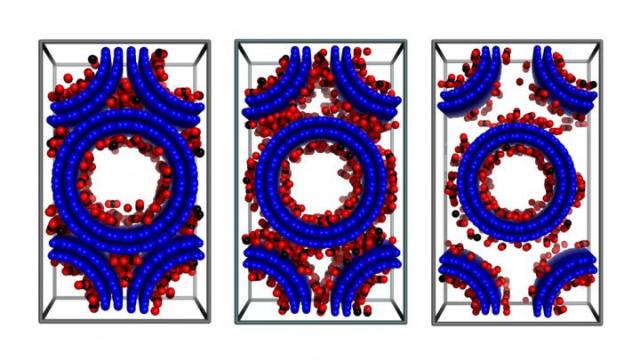A team of scientists from the Technische Universität Darmstadt in Germany and the Indian Institute of Technology, Kanpur are exploring ways of using vertically aligned carbon nanotubes (VACNTs) for capturing and storing specific green house gases.
 Snapshots of CO2 adsorption in double-walled carbon nanotube arrays (with an inner tube diameter of 2r=3 nanometers and various inter-tube distance at T=303 K and p=1 bar). Credit: Rahimi/Babu
Snapshots of CO2 adsorption in double-walled carbon nanotube arrays (with an inner tube diameter of 2r=3 nanometers and various inter-tube distance at T=303 K and p=1 bar). Credit: Rahimi/Babu
The combustion of fossil fuels, such as petroleum, coal and natural gas, contributes to global warming by emitting the so-called “greenhouse gases” into the Earth’s atmosphere. Researchers from across the world are working on developing materials that can capture and store these gases. In this work, the research team focussed on trapping two greenhouse gases – carbon dioxide (CO2) and sulphur dioxide (SO2).
The team has published its findings in the Journal of Chemical Physics, an AIP publishing. As per the published report, modulating the morphological parameters of VACNTs, such as their height, thickness, and the distance between the nanotubes, can influence their gas adsorption characteristic.
"These parameters are fundamental for 'tuning' the hierarchical pore structure of the VACNTs," explained Mahshid Rahimi and Deepu Babu. They are the lead authors of the report and doctoral students pursuing theoretical physical chemistry and inorganic chemistry at the Technische Universität Darmstadt."This hierarchy effect is a crucial factor for getting high-adsorption capacities as well as mass transport into the nanostructure. Surprisingly, from theory and by experiment, we found that the distance between nanotubes plays a much larger role in gas adsorption than the tube diameter does."
Generally, carbon materials that are used for gas adsorption/desorption applications exhibit large hysteresis effects, where the value of physical properties lag behind the changes in the cause because of pore size distribution and structure. Therefore, the team focussed on gaining in-depth theoretical and experimental insights into the basics of adsorption and selectivity of carbon materials and their application potential.
VACNTs were chosen for the study because they are produced using a chemical vapour deposition process. Carbon nanotubes produced by this process have a dense growth and are tightly packed. VACNTs are "ideal model structures on which theory and experiment can be probed," said Rahimi and Babu.
Why is the dense growth and tight packing of carbon nanotubes important? "It allows our team to introduce well-defined adsorption sites that can be explored theoretically and creates an ideal symbiosis between experiment and theory," Rahimi said. "For theory, we rely on a molecular simulation method to simulate the adsorption process so it's as similar to the experiment as possible. This lets us predict what will happen in a much cheaper way, as well as explore what's happening in the experimentally studied system more deeply."
The latest findings by the team establish the superiority of gas adsorption in VACNTs over general adsorption materials like porous carbon, metal organic frameworks, and zeolites, within the mid-pressure (30 bars) region.
"This adsorption range is important for technologically relevant processes like gas storage for automotive purposes," noted Rahimi.
The team plans to dig deeper into gas adsorption and selectivity in VACNT structures under electrical charging conditions.
"Beyond this, we'll introduce specific atoms to achieve controlled elemental doping of the carbon nanotubes," she added. "This will allow us to further tune the gas selectivity. Another area we'll also explore is 'controlled carbon nanotube openings' in such VACNTs to increase the gas adsorption."
Source: https://www.aip.org/